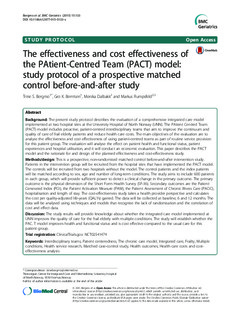| dc.contributor.author | Bergmo, T.S. | |
| dc.contributor.author | Berntsen, G.K. | |
| dc.contributor.author | Dalbakk, M. | |
| dc.contributor.author | Rumpsfeld, M. | |
| dc.date.accessioned | 2018-02-16T12:49:19Z | |
| dc.date.available | 2018-02-16T12:49:19Z | |
| dc.date.issued | 2015 | |
| dc.identifier.citation | Bergmo, T. S., Berntsen, G. K., Dalbakk, M. & Rumpsfeld, M. (2015). The effectiveness and cost effectiveness of the PAtient-Centred Team (PACT) model: Study protocol of a prospective matched control before-and-after study. BMC Geriatrics, 15(133). | nb_NO |
| dc.identifier.uri | http://hdl.handle.net/11250/2485404 | |
| dc.description.abstract | Background: The present study protocol describes the evaluation of a comprehensive integrated care model implemented at two hospital sites at the University Hospital of North Norway (UNN). The PAtient Centred Team (PACT) model includes proactive, patient-centred interdisciplinary teams that aim to improve the continuum and quality of care of frail elderly patients and reduce health care costs. The main objectives of the evaluation are to analyse the effectiveness and cost effectiveness of using patient-centred teams as part of routine service provision for this patient group. The evaluation will analyse the effect on patient health and functional status, patient experiences and hospital utilisation, and it will conduct an economic evaluation. This paper describes the PACT model and the rationale for and design of the planned effectiveness and cost-effectiveness study.
Methods/design: This is a prospective, non-randomised matched control before-and-after intervention study. Patients in the intervention group will be recruited from the hospital sites that have implemented the PACT model. The controls will be recruited from two hospitals without the model. The control patients and the index patients will be matched according to sex, age and number of long-term conditions. The study aims to include 600 patients in each group, which will provide sufficient power to detect a clinical change in the primary outcome. The primary outcome is the physical dimension of the Short Form Health Survey (SF-36). Secondary outcomes are the Patient Generated Index (PGI), the Patient Activation Measure (PAM), the Patient Assessment of Chronic Illness Care (PACIC), hospitalisation and length of stay. The cost-effectiveness study takes a health provider perspective and calculates the cost per quality-adjusted life-years (QALYs) gained. The data will be collected at baseline, 6 and 12 months. The data will be analysed using techniques and models that recognise the lack of randomisation and the correlation of cost and effect data.
Discussion: The study results will provide knowledge about whether the integrated care model implemented at UNN improves the quality of care for the frail elderly with multiple conditions. The study will establish whether the PAC. T model improves health and functional status and is cost effective compared to the usual care for this patient group. | nb_NO |
| dc.publisher | BMC Geriatrics | nb_NO |
| dc.rights | Navngivelse 4.0 Internasjonal | * |
| dc.rights.uri | http://creativecommons.org/licenses/by/4.0/deed.no | * |
| dc.subject | Interdisciplinary teams | nb_NO |
| dc.subject | Patient centeredness | nb_NO |
| dc.subject | The chronic care model | nb_NO |
| dc.subject | Frailty | nb_NO |
| dc.title | The effectiveness and cost effectiveness of the PAtient-Centred Team (PACT) model: Study protocol of a prospective matched control before-and-after study | nb_NO |
| dc.type | Journal article | nb_NO |
| dc.source.volume | 15 | nb_NO |
| dc.source.journal | BMC Geriatrics | nb_NO |
| dc.source.issue | 133 | nb_NO |
| dc.identifier.doi | 10.1186/s12877-015-0133-x | |

